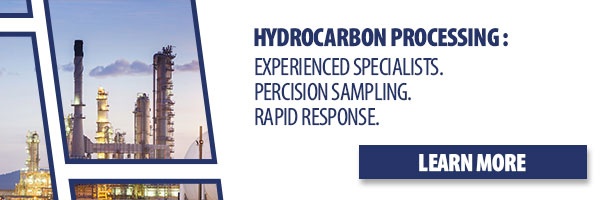
Aluminum alkyls are a family of organo-aluminums often used as catalysts in the polymerization of olefins and dienes in hydrocarbon plants. Some plants use aluminum alkyls in their manufacturing operations for a variety of uses, from afterburner sustainers for jet engines to reducing agents. Learn how one plant ensured personnel and environmental safety with aluminum alkyl sampling.
Aluminum alkyls are highly reactive and pyrophoric, meaning they can ignite spontaneously in the air, they react violently with water and are extremely corrosive. Alkyls can cause severe skin burns and irreversible eye damage, and can be harmful if inhaled, ingested or absorbed through the skin.
For safe handling of aluminum alkyls, it’s critical to:
- Contain – Prevent uncontrolled escape of alkyls and contact with reactive materials.
- Guard – In case aluminum alkyls should escape from their enclosed system, shield operators and equipment from potential leaks, sprays or splashes.
- Protect – As a third line of defense, require that personnel wear full personal protective equipment when there is a possibility of exposure.
Representative sampling with alkyls
Establishing a sampling program for aluminum alkyls in refining processes requires special considerations for successful and safe operations. Representative sampling combines safety, simplicity and accuracy to deliver benefits unmatched by other sampling methods.
It’s critical to ensure quality control and to determine product properties and composition. This will support accurate fiscal calculations, allocations and loss control. What’s more, a properly designed sampling system ensures representative process samples are repeatable and reliable, every time.
Case Study: SAFELY SAMPLING ALUMINUM ALKYLS
One hydrocarbon plant customer reported clogging issues within their sampling system. A service team was dispatched to observe the panels. During this in-person observation, it was discovered that the operators were not following posted operating procedures, resulting in samples getting trapped between the isolation valve and the sample valve. This led to four blowouts of high-strength fittings on one panel and a destroyed isolation valve on another panel.
Diluting aluminum alkyls with hydrocarbon solvents, such as benzene, hexane and heptane, can make them nonpyrophoric and less hazardous for safer handling. But even diluted alkyls will smoke in the air, burn the skin and have flammable vapors.
In this case, the aluminum alkyls were diluted with benzene and butane. But during the product selection phase of the process, the customer reported that the vapor pressure of aluminum alkyls was 5 psi. Unfortunately, there was no mention of butane, which has a vapor pressure of 35 psi. This lack of application information partially contributed to the plant’s sampling challenges.
ON-SITE SERVICE
To address this challenge, a team effort was coordinated between sales, engineering, customer service and production to service the panel so it could safely sample both the aluminum alkyls and the butane. The customer was guided through many twists, turns, and changes at every stage of the process. However, key communication with stakeholders allowed for a successful transition throughout service.
This project illustrates two critical elements of sampling aluminum alkyls:
- Ensure vendors have accurate application information
- Coordinate start-up so that the sampling vendor’s service group is on-site to troubleshoot and train operators to immediately recognize issues before they lead to bigger challenges



